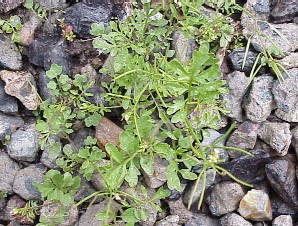Scientific name: Cardamine flexuosa With.
Synonym: Cardamine sylvatice Link.Common name: FlickweedFamily: BrassicaceaeOrigin:Native of Europe. Habit:Herb with slender, erect, slightly zig-zaging stems up to 50 cm tall, branching above as well as at the base. Habitat:Weed of tended areas, such as gardens and plant nurseries. Found where there is moisture and shade. General description:Stems and leavesStems grow to 50 cm long, branching at the base and also higher up the stem. Plants are sparsely hairy or hairless. Leaves are compound (pinnate) up to 6cm long, with 3-6 pairs of kidney-shaped (reniform) to oval leaflets and a larger terminal leaflet. Leaflets all have rounded teeth. Leaves on the flowering stems differ from the basal leaves, often being larger with narrower leaflets. However, the leaves on the highest parts of the stem tend to decrease in size. Flowers and fruitThe inflorescence is a spike of small white flowers with four petals (about 2.5-3 mm long). The flowers usually have six stamens and most flowering occurs in winter. Fruit are elongated, cylindrical (12-25 x 1 mm in size), and tending to curve upwards on upward arching stalks (pedicels) 5-10 mm long. Distinguishing characteristics:Cardamine species are small pale green herbs with lobed or pinnate leaves. They produce long fruit containing small seeds which may ‘flick’ as they are disturbed. Cardamine flexuosa (flickweed) has zig-zag stems which branch at the base and higher up the stem. Cardamine hirsuta (common bittercress) branches at the base only. Usually, there are six stamens in C. flexuosa flowers, while C. hirsuta always has four stamens in its flowers. Noxious status:Not noxious. Sources:Kleinschmidt, H.E., Holland, A. and Simpson, P. (1996). Suburban Weeds. 3rd Edition. Department of Primary Industries, Brisbane. Stanley, T.E. and Ross, E.M. (1983-1989). Flora of South-eastern Queensland. Volume 1. Department of Primary Industries, Brisbane. |
Brisbane
St Lucia, QLD 4072
+61 7 3365 1111
© 2009 The University of Queensland



